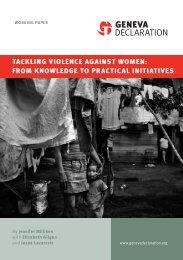Global Burden of Armed Violence - The Geneva Declaration on ...
Global Burden of Armed Violence - The Geneva Declaration on ...
Global Burden of Armed Violence - The Geneva Declaration on ...
You also want an ePaper? Increase the reach of your titles
YUMPU automatically turns print PDFs into web optimized ePapers that Google loves.
American countries have similar trends, even if<br />
they are not as acute as Guatemala (Map 4.3). In<br />
Africa, the chances <str<strong>on</strong>g>of</str<strong>on</strong>g> a murder resulting in a c<strong>on</strong>-<br />
victi<strong>on</strong> are <strong>on</strong>ly around 11 per cent. This figure<br />
increases to 18 per cent in South Africa and stands<br />
in comparis<strong>on</strong> to 56 per cent in the United States<br />
and 61 per cent in the United Kingdom (UNODC,<br />
2005, p. 13).<br />
<str<strong>on</strong>g>The</str<strong>on</strong>g> inability to prosecute <str<strong>on</strong>g>of</str<strong>on</strong>g>fenders, corrupti<strong>on</strong>,<br />
and the absence <str<strong>on</strong>g>of</str<strong>on</strong>g> adequate pris<strong>on</strong> facilities<br />
foster a percepti<strong>on</strong> <str<strong>on</strong>g>of</str<strong>on</strong>g> impunity for homicide. <str<strong>on</strong>g>The</str<strong>on</strong>g><br />
experience <str<strong>on</strong>g>of</str<strong>on</strong>g> justice reform in Jamaica and the<br />
Dominican Republic highlights that better coopera-<br />
ti<strong>on</strong> am<strong>on</strong>g the police, justice, and correcti<strong>on</strong>al serv-<br />
ices (supported by integrated informati<strong>on</strong> systems)<br />
and embedding justice reform in a broader multi-<br />
sector strategy <str<strong>on</strong>g>of</str<strong>on</strong>g> violence and crime preventi<strong>on</strong><br />
can help in dealing with impunity and increase the<br />
effectiveness <str<strong>on</strong>g>of</str<strong>on</strong>g> instituti<strong>on</strong>al resp<strong>on</strong>ses to crime<br />
(UNODC and World Bank, 2007, pp. 126–27).<br />
C<strong>on</strong>clusi<strong>on</strong>: knowledge gaps<br />
and policy implicati<strong>on</strong>s<br />
<str<strong>on</strong>g>The</str<strong>on</strong>g> use <str<strong>on</strong>g>of</str<strong>on</strong>g> internati<strong>on</strong>al homicide data as an in-<br />
direct means to assess the global burden <str<strong>on</strong>g>of</str<strong>on</strong>g> armed<br />
violence is in its infancy. This chapter has made<br />
use <str<strong>on</strong>g>of</str<strong>on</strong>g> extensive and rigorous data gathering and<br />
analysis in order to provide a comprehensive<br />
snapshot <str<strong>on</strong>g>of</str<strong>on</strong>g> the scale and magnitude <str<strong>on</strong>g>of</str<strong>on</strong>g> lethal<br />
n<strong>on</strong>-c<strong>on</strong>flict armed violence. It has also attempted<br />
to provide some indicati<strong>on</strong> <str<strong>on</strong>g>of</str<strong>on</strong>g> recent trends, and<br />
<str<strong>on</strong>g>of</str<strong>on</strong>g> the possible spatial, demographic, and socio-<br />
ec<strong>on</strong>omic factors that might affect levels <str<strong>on</strong>g>of</str<strong>on</strong>g><br />
armed violence.<br />
Some cross-nati<strong>on</strong>al comparis<strong>on</strong>s <str<strong>on</strong>g>of</str<strong>on</strong>g> homicide levels<br />
have recently begun to appear in development-<br />
related publicati<strong>on</strong>s, including the Human Develop-<br />
Box 4.5 Violent death in the city<br />
Received wisdom claims that victimizati<strong>on</strong> by more serious crimes is correlated<br />
with increases in the proporti<strong>on</strong> <str<strong>on</strong>g>of</str<strong>on</strong>g> the populati<strong>on</strong> <str<strong>on</strong>g>of</str<strong>on</strong>g> a country living<br />
in larger cities. Criminologists frequently argue that urban density is thought<br />
to be associated with crime, since greater c<strong>on</strong>centrati<strong>on</strong>s <str<strong>on</strong>g>of</str<strong>on</strong>g> people lead to<br />
competiti<strong>on</strong> for limited resources, greater stress, and increased c<strong>on</strong>flict<br />
(Glaeser and Sacerdote, 1996; Van Dijk, 1998, p. 69; Naudé, Prinsloo, and<br />
Ladikos, 2006).<br />
When it comes to urban armed violence, however, its frequency and effect<br />
is strikingly heterogeneous and it results from multiple causes. It is linked<br />
to factors such as the drug trade, the availability <str<strong>on</strong>g>of</str<strong>on</strong>g> weap<strong>on</strong>s, and forms <str<strong>on</strong>g>of</str<strong>on</strong>g><br />
social organizati<strong>on</strong> such as street gangs and militia or quasi-militia groups<br />
(Small Arms Survey, 2007). While not all urban violence ends in homicide,<br />
homicide rates are related to more general violent acts.<br />
<str<strong>on</strong>g>The</str<strong>on</strong>g> complexity <str<strong>on</strong>g>of</str<strong>on</strong>g> urban armed violence is highlighted by the fact that there<br />
is no clear correlati<strong>on</strong> between city populati<strong>on</strong> and levels <str<strong>on</strong>g>of</str<strong>on</strong>g> urban homicide<br />
(Small Arms Survey, 2007). In order to provide further insight into differences<br />
between urban and rural homicide rates, research was undertaken<br />
to identify homicide rates per 100,000 populati<strong>on</strong> in major cities. Data for<br />
the largest available city in 67 countries was located. <str<strong>on</strong>g>The</str<strong>on</strong>g> cities ranged<br />
from a populati<strong>on</strong> <str<strong>on</strong>g>of</str<strong>on</strong>g> just over 6,000 pers<strong>on</strong>s to more than 14 milli<strong>on</strong> pers<strong>on</strong>s.<br />
<str<strong>on</strong>g>The</str<strong>on</strong>g> median city populati<strong>on</strong> was slightly over 1.2 milli<strong>on</strong>. <str<strong>on</strong>g>The</str<strong>on</strong>g> results<br />
<str<strong>on</strong>g>of</str<strong>on</strong>g> this comparis<strong>on</strong> are presented in Figure 4.10 and are summarized by<br />
subregi<strong>on</strong>. Insufficient data prevented meaningful comparis<strong>on</strong>s being<br />
carried out for Africa, Oceania, and Asia, with the excepti<strong>on</strong> <str<strong>on</strong>g>of</str<strong>on</strong>g> East Asia.<br />
<str<strong>on</strong>g>The</str<strong>on</strong>g> methodology for major city/rest <str<strong>on</strong>g>of</str<strong>on</strong>g> country comparis<strong>on</strong>s is described<br />
in full in the <strong>on</strong>-line appendix (www.genevadeclarati<strong>on</strong>.org).<br />
A comm<strong>on</strong> theme in the literature is that crime levels are higher in urban<br />
areas than rural areas (UN-HABITAT, 2006). While this may be true for<br />
North America, Central Asia and Transcaucasia, West and Central Europe,<br />
and South-east Europe, the reverse appears to be true for East Europe,<br />
Central America, and East Asia. South America shows <strong>on</strong>ly a small difference<br />
between urban and rural homicide rates.<br />
A first possible explanati<strong>on</strong> for differences may relate to differing degrees<br />
<str<strong>on</strong>g>of</str<strong>on</strong>g> urbanizati<strong>on</strong> in the rest <str<strong>on</strong>g>of</str<strong>on</strong>g> the country. <str<strong>on</strong>g>The</str<strong>on</strong>g> ‘major city’ rate may, for<br />
instance, be compared with a ‘rest <str<strong>on</strong>g>of</str<strong>on</strong>g> country’ rate that itself c<strong>on</strong>tains many<br />
large urban centres. A look at urbanizati<strong>on</strong> rates <strong>on</strong>ly partially explains the<br />
differences, however. While a low urbanizati<strong>on</strong> rate in Central Asia and<br />
Transcaucasia (50 per cent) corresp<strong>on</strong>ds with a homicide rate <strong>on</strong>e and a half<br />
times as high in the largest city as for rest <str<strong>on</strong>g>of</str<strong>on</strong>g> country, the pattern is more<br />
complicated in other subregi<strong>on</strong>s. <str<strong>on</strong>g>The</str<strong>on</strong>g> four countries examined in East<br />
Europe and the five countries in East Asia, for example, show average urbanizati<strong>on</strong><br />
rates (both around 60 per cent) lower than those for the countries<br />
examined in North America (80 per cent) and West and Central Europe (73<br />
per cent). 23 This is despite the fact that East Europe and East Asia show<br />
higher homicide rates for ‘rest <str<strong>on</strong>g>of</str<strong>on</strong>g> country’ than major cities. ##<br />
85<br />
NON- CO N F L I C T A R M E D V I O L E N C E<br />
1<br />
2<br />
3<br />
4<br />
5<br />
6<br />
7









